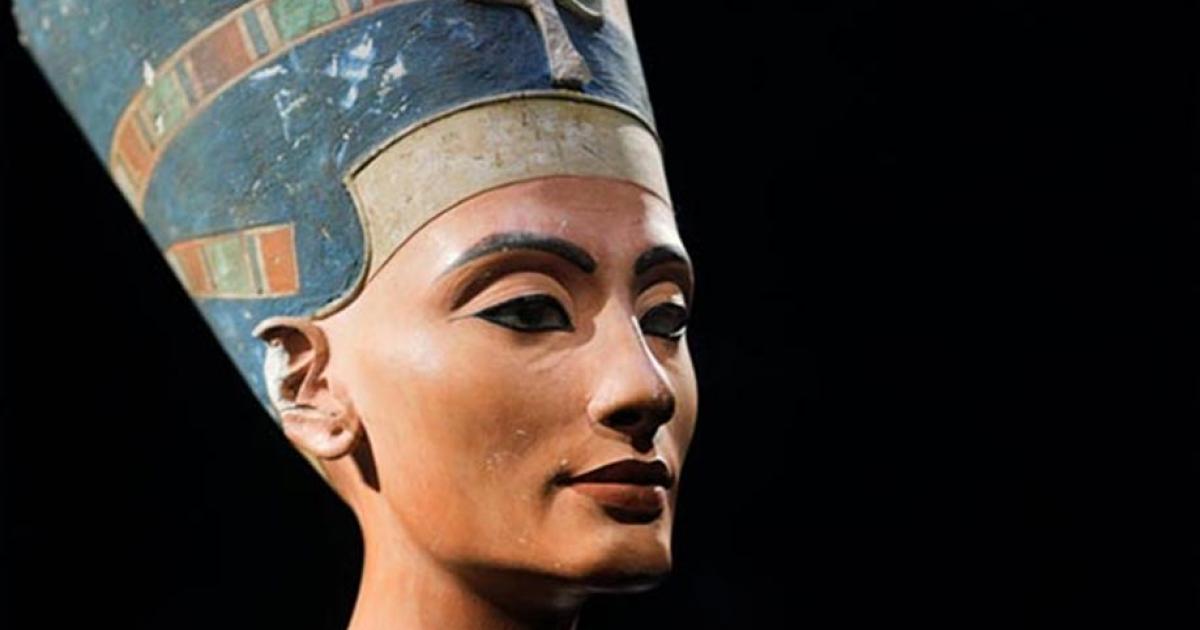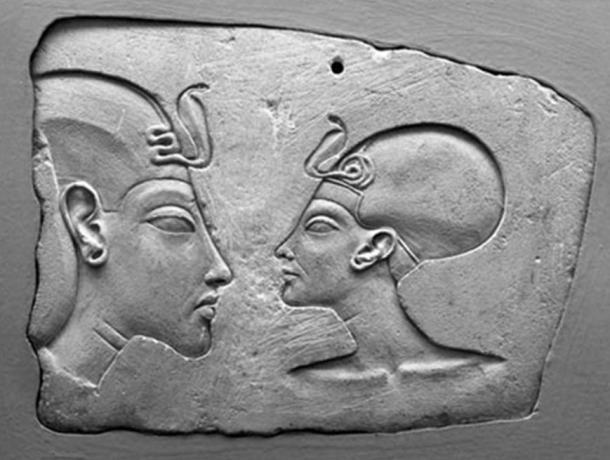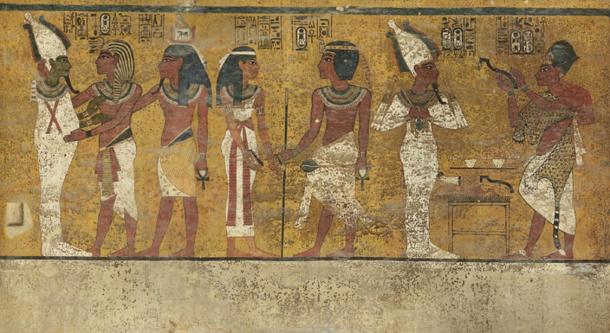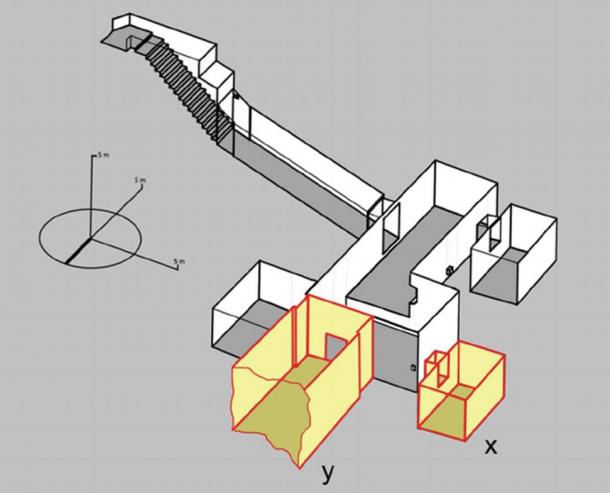
The Elusive Tomb of Queen Nefertiti may lie behind the walls of Tutankhamun's Burial Chamber
An archaeologist studying electronic scans of the walls of the ancient Egyptian King Tutankhamun's tomb thinks he has found a false wall that may lead to the tomb of Nefertiti, the famous successor to Akhenaten and the probable mother of Tutankhamun. The location of Nefertiti's tomb has been one of Egyptology’s biggest mysteries, and archaeologist Nicholas Reeves thinks further exploration behind the walls of King Tutankhamun's tomb at the Amarna Royal Tombs in the Valley of Kings is warranted.
“Cautious evaluation of the Factum Arte scans over the course of several months has yielded results which are beyond intriguing: indications of two previously unknown doorways, one set within a larger partition wall and both seemingly untouched since antiquity,” writes Reeves in a new paper on his study of the scans. “The implications are extraordinary: for, if digital appearance translates into physical reality, it seems we are now faced not merely with the prospect of a new, Tutankhamun-era storeroom to the west; to the north appears to be signalled a continuation of tomb KV 62 and within these uncharted depths an earlier royal interment—that of Nefertiti herself, celebrated consort, co-regent, and eventual successor of pharaoh Akhenaten.”

The Wilbour Plaque, Brooklyn Museum. Nefertiti is shown nearly as large as her husband, indicating her importance. Image source: Brooklyn Museum.
The paintings on the walls of King Tutankhamun's burial chamber, which Factum Arte scanned and which the University of Arizona's Reeves studied, obscure the surface. But Reeves says there are telltale signs in the cracks and fissures of the wall that may indicate rooms behind the walls, which have been assumed to be solid limestone.
Howard Carter found Tutankhamun's tomb intact in 1922 with more than 5,000 artifacts.
The paintings within this [burial chamber] room document the principal stages in Tutankhamun's physical and spiritual transition from this world to the realm of the gods. Although affected by serious mould growth, these painted surfaces remain both sound and intact. Covering as they do virtually every inch of the walls, the underlying architecture is almost wholly obscured. Carter, followed by all Egyptologists since, seems to have accepted that beneath lay only bedrock, influenced in this understanding by the fact that four eccentrically placed amulet emplacements cut through the decoration to expose solid limestone.
- The Mysterious Disappearance of Nefertiti, Ruler of the Nile
- The Quest to find Nefertiti, Queen of the Nile
- Pharaoh Akhenaten
- The Art of Amarna: Akhenaten and his life under the Sun

Screenshot from a Factum Arte scan of King Tutankhamun's burial chamber, behind which, a researcher says, may lie the tomb of Queen Nefertiti. (Factum-arte.org scan)
Reeves posits that when Tutankhamun died in 1332 BC, his tomb displaced part of Nefertiti's tomb and assumed some of her burial goods and space because of his untimely and unexpected death. Further, though he says it can't be proven yet, he speculates Nefertiti herself “will have inherited, adapted, and employed the full, formal burial equipment originally produced for Akhenaten.”
Though King Tutankamun's tomb was richly decorated and appointed, it was small for a king. Reeves says it may be an extension of Nefertiti's larger tomb.
Nefertiti is one of the most famous queens of ancient Egypt, second only to Cleopatra. While many aspects of her life are well-documented, there are many mysteries surrounding her death and burial. While hundreds of royal mummies have already been recovered in Egypt, Nefertiti’s mummy has remained elusive.

Theban Mapping Project's diagram of King Tutankamun's known tomb, in gray, and two possible new rooms in yellow and red, one of which, a researcher says, cold be Queen Nefertiti's burial chamber.
Neferneferuaten Nefertiti lived from 1370 BC until 1340 BC. She was married to the Egyptian Pharaoh Akhenaten, who gave her many titles, including: Great Royal Wife, Hereditary Princess, Great of Praises, Lady of Grace, Sweet of Love, Lady of The Two Lands, Great King’s Wife, Lady of all Women, and Mistress of Upper and Lower Egypt. Nefertiti was known for being very beautiful, and her name means “the beautiful one has come.” While little is known about Nefertiti’s origins, it is believed that she was from an Egyptian town known as Akhmim and was closely related to a high official named Ay. Others believe Nefertiti came from a foreign country.
In an interview with The Economist, Reeves said: “If I’m wrong, I’m wrong; but if I’m right this is potentially the biggest archaeological discovery ever made.”
Featured image: The iconic bust of Nefertiti, discovered by Ludwig Borchardt, is part of the Ägyptisches Museum Berlin collection, currently on display in the Altes Museum. Image Source.
By Mark Miller
















Comments
One of the stelae at Armana referred to Nefertiti as coming from the north, and as being "fair of face". She may have been a princess from a northern region which worshipped the sun and influenced her husband to change to the monotheistic religion of the Aten.
SO WHAT ???
Navarotete is a Bulgarian name meaning: A Lady (tete) of God Ra Truth (VaRa). Moreover, Navarotete has a fair complex beauty. On the other side Tuthankamon is also e Bulgarian name meaning This God (Toth) Angel (Ankh/Ang) Man.
Not sure what your point is, who cares what it means in bulgarian. What these were bulgarian Africans?Lol.
Navarotete is a Bulgarian name meaning: A Lady (tete) of God Ra Truth (VaRa). Moreover, Navarotete has a fair complex beauty. On the other side Tuthankamon is also e Bulgarian name meaning This God (Toth) Angel (Ankh/Ang) Man.